O C Diver
Guru
- Joined
- Dec 16, 2010
- Messages
- 12,867
- Location
- USA
- Vessel Name
- Slow Hand
- Vessel Make
- Cherubini Independence 45
I've threatened several times to post this in totality, and am finally getting around to it. During my 2014 - 2015 refit I added a heating loop that runs off the engine's coolant system for heat while underway. So here are the details. Before I start, I should explain that I have CDO (Obsessive Compulsive Disorder [ in alphabetical order as it should be]). A less obsessive person could replicate this with much less effort.
The object was to circulating engine coolant through radiators through out the boat to heat it while underway. The idea is the same as most cars being heated off waste engine heat. For my boat, radiators in the saloon, pilothouse and master stateroom were chosen. In each location I installed a Heatercraft 28,000 BTU heater.
https://heatercraft.com/collections...s/500-grill-face-series?variant=2074878050335
This is the one in my forward stateroom.
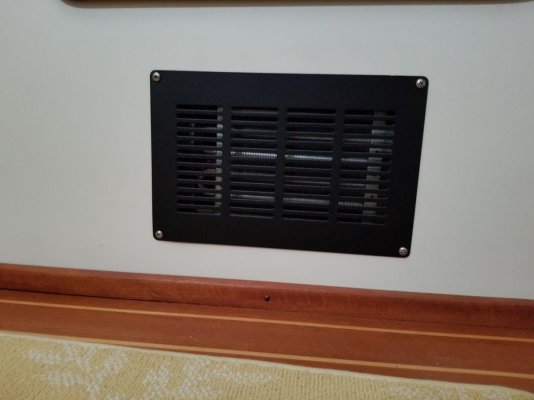
They offer different size options, ducting accessories, and voltages. The ducting models would allow you to heat more than one room or mount them as windshield defrosters.
https://heatercraft.com/collections/all-marine-heaters
If you plan to install one of these, it's important to remember the blowers push a lot of air. The small louvered door to the left is an adequate air supply.
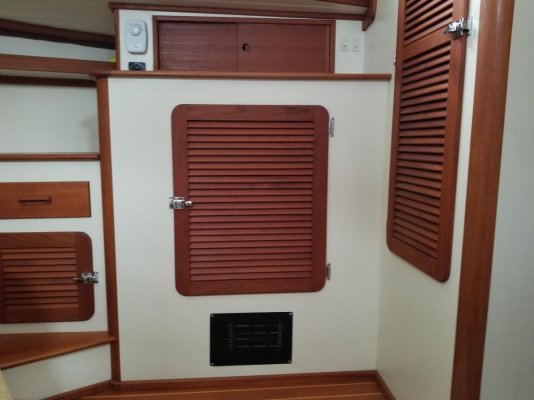
Coolant passes continuously through the heater. What heats the room is a 260 CFM blower pushing air over the radiator coil in the heater. The unit comes with a 3 speed blower switch. In addition to being able to regulate heater output, I wanted to be able to regulate room temperature. The blowers draw as much as 9 amps, so a normal HVAC thermostat won't work. What I installed are electric base board heat thermostats which are able to handle far more amps and have bimetal temperature sensors so that boat movement doesn't effect them.
Hear are the controls for my stateroom heater. The thermostat for temperature control and the blower speed switch with off position.
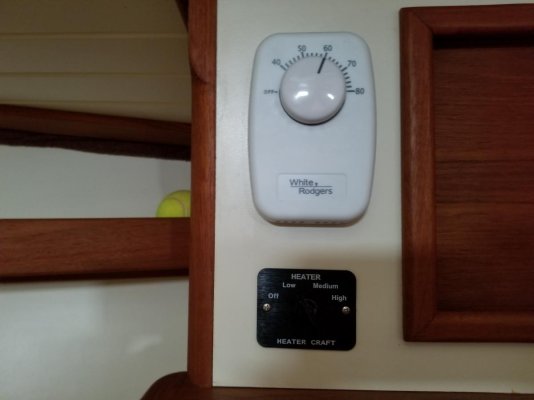
Plumbing the Heaters:
First you need to find where to take coolant from your engine and where to return it to the engine. My John Deere dealer told me there was a 1/2" female pipe fitting at the back of the cylinder head for such applications. Should the system develop a leak, I wanted to be able to block tthe loop with 2 quarter turn valves. So this is coolant out of the cylinder head with a valve.
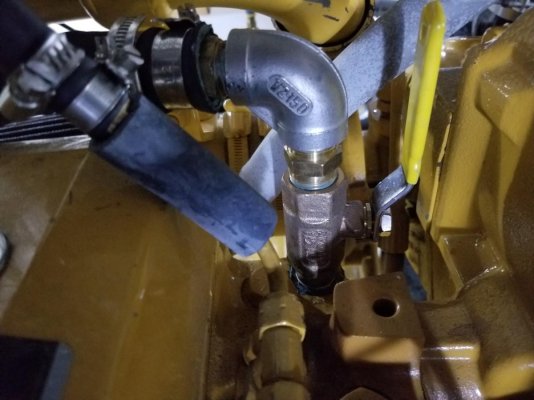
Here is the coolant return feeding directly into the water pump.
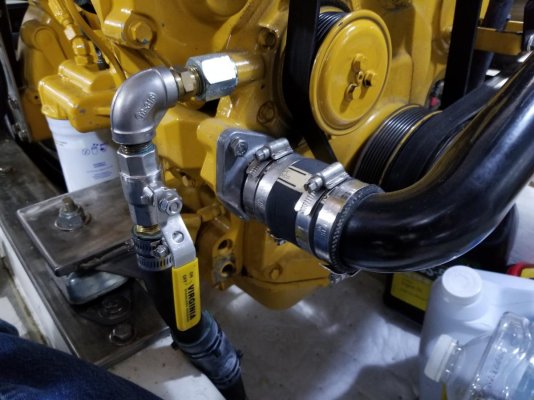
My boat has a domestic water heater with a heat exchanger to make hot water with engine heat. So the coolant loop first goes to the water heater. On my system I installed a 3 way valve on the discharge from the water heater heat exchanger. The valve allows me to direct flow on to the cabin heaters or return it to the engine during the summer when I don't need cabin heat. In this picture the valve is directing flow back to the engine. The hose going up feeds the loop pump.
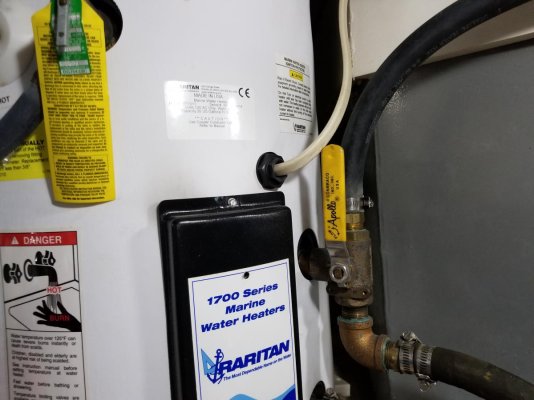
The loop pump may or may not be necessary depending on the size of the loop. The first system I built was on my charter boat, had one heater, and the loop length was under 15'. There was plenty of flow from the engine pump.
This system has 3 heater coils and over 100' of loop. So, I decided to add a pump. The pump is a sealed magnetic drive designed for hot water. While coolant will flow around the loop without this pump, it's fairly slow. Understand that BTU output from the heater is directly tied to BTUs in the coolant. Within reason, the more coolant you have flowing through the coil, the more BTUs you can push into the room.
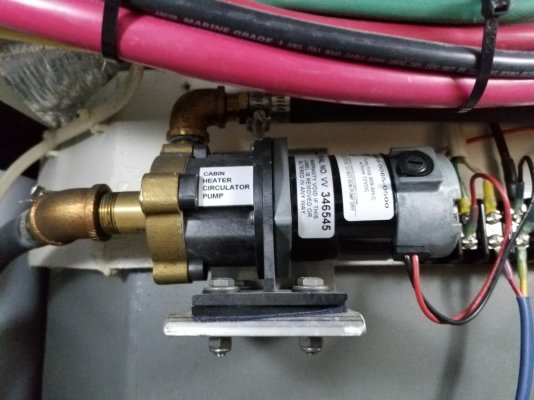
So basically we have three heaters with controls throughout the boat. There's a water heater with a heat exchanger and 3 way valve. Finally, the loop pump to speed up the water flow. Now it's time to over engineer the system.
The Land of CDO
This is a picture of my thermostats (there are 2) housing. Just to the left of the dipstick is a silver tag. It's attached to a solid brass temperature switch. It senses loop temperature in the engine regardless of whether the thermostats are open. At 175 degrees it closes; at 165 degrees it opens. If going very slow or idling, I didn't want the system to pull the engine temperature way down.
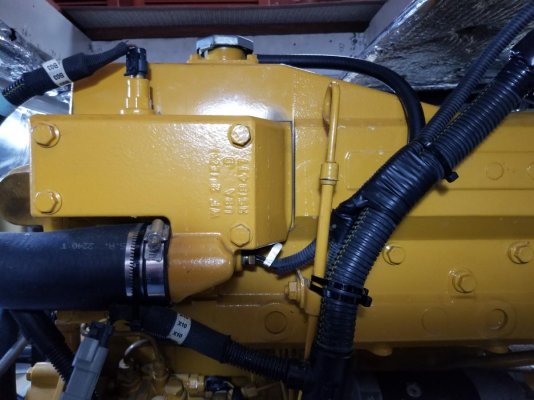
Follow me at your own risk
So the system needs some excessive complication (mostly to satisfy my CDO). It is powered by a circuit on the main breaker panel. Each Blower has it's own fuse as does the pump. Each blower thermostat is a double pole switch, one for blower and one for the pump. Any thermostat can activate its blower and turn the pump on, but if none are calling for heat, the pump remains off. The negative lead of the pump and relay are controlled by the temperature switch on the engine, so that a sub 165 degree engine temperature turns off the pump and opens the relay powering the 3 heater blower circuits.
Got all that?
In the picture, the 4 fuses to the left are for the blowers and pump. Below is a 3 pole relay and some creative wiring.
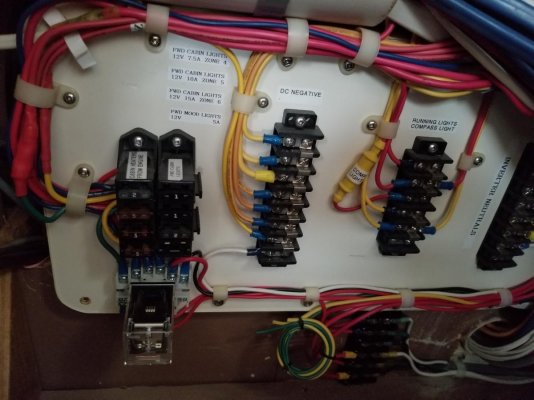
Additional Information and Evaluation:
Because one of the heaters is in the pilothouse, about 6' above the engine, and there is 100' of loop hose, I added a reservoir that holds a quart and can handle loop pressure. Since it's the highest point, it makes filling the loop easy and provides a place to catch air bubbles in the system. I don't know if the pumps could have overcome the head pressure otherwise.
The system works extremely well. On a 22 degree night I headed down Chesapeake Bay in late January of 2016. With the boat around freezing, the pilothouse was in the 70s with in a half hour. The saloon took probably a couple of hours, lots of objects and walls to warm up. The staterooms took most of the day to warm up. The stateroom heater is the last in the loop with the lowest coolant temperature and has some walls in contact with the ocean. Another heater in the second stateroom would probably make all the difference once the saloon and pilothouse units started cycling off and on.
When cruising, I burn 2 GPH. So all that heat is coming from a very low fuel burn. The engine produces enough heat to keep it above 170 degrees, but it's unlikely that the thermostats are opening. My plan was to increase speed and fuel burn if there wasn't enough BTUs. That hasn't been necessary so far.
Ted
The object was to circulating engine coolant through radiators through out the boat to heat it while underway. The idea is the same as most cars being heated off waste engine heat. For my boat, radiators in the saloon, pilothouse and master stateroom were chosen. In each location I installed a Heatercraft 28,000 BTU heater.
https://heatercraft.com/collections...s/500-grill-face-series?variant=2074878050335
This is the one in my forward stateroom.

They offer different size options, ducting accessories, and voltages. The ducting models would allow you to heat more than one room or mount them as windshield defrosters.
https://heatercraft.com/collections/all-marine-heaters
If you plan to install one of these, it's important to remember the blowers push a lot of air. The small louvered door to the left is an adequate air supply.

Coolant passes continuously through the heater. What heats the room is a 260 CFM blower pushing air over the radiator coil in the heater. The unit comes with a 3 speed blower switch. In addition to being able to regulate heater output, I wanted to be able to regulate room temperature. The blowers draw as much as 9 amps, so a normal HVAC thermostat won't work. What I installed are electric base board heat thermostats which are able to handle far more amps and have bimetal temperature sensors so that boat movement doesn't effect them.
Hear are the controls for my stateroom heater. The thermostat for temperature control and the blower speed switch with off position.

Plumbing the Heaters:
First you need to find where to take coolant from your engine and where to return it to the engine. My John Deere dealer told me there was a 1/2" female pipe fitting at the back of the cylinder head for such applications. Should the system develop a leak, I wanted to be able to block tthe loop with 2 quarter turn valves. So this is coolant out of the cylinder head with a valve.

Here is the coolant return feeding directly into the water pump.

My boat has a domestic water heater with a heat exchanger to make hot water with engine heat. So the coolant loop first goes to the water heater. On my system I installed a 3 way valve on the discharge from the water heater heat exchanger. The valve allows me to direct flow on to the cabin heaters or return it to the engine during the summer when I don't need cabin heat. In this picture the valve is directing flow back to the engine. The hose going up feeds the loop pump.

The loop pump may or may not be necessary depending on the size of the loop. The first system I built was on my charter boat, had one heater, and the loop length was under 15'. There was plenty of flow from the engine pump.
This system has 3 heater coils and over 100' of loop. So, I decided to add a pump. The pump is a sealed magnetic drive designed for hot water. While coolant will flow around the loop without this pump, it's fairly slow. Understand that BTU output from the heater is directly tied to BTUs in the coolant. Within reason, the more coolant you have flowing through the coil, the more BTUs you can push into the room.

So basically we have three heaters with controls throughout the boat. There's a water heater with a heat exchanger and 3 way valve. Finally, the loop pump to speed up the water flow. Now it's time to over engineer the system.
The Land of CDO

This is a picture of my thermostats (there are 2) housing. Just to the left of the dipstick is a silver tag. It's attached to a solid brass temperature switch. It senses loop temperature in the engine regardless of whether the thermostats are open. At 175 degrees it closes; at 165 degrees it opens. If going very slow or idling, I didn't want the system to pull the engine temperature way down.

Follow me at your own risk
So the system needs some excessive complication (mostly to satisfy my CDO). It is powered by a circuit on the main breaker panel. Each Blower has it's own fuse as does the pump. Each blower thermostat is a double pole switch, one for blower and one for the pump. Any thermostat can activate its blower and turn the pump on, but if none are calling for heat, the pump remains off. The negative lead of the pump and relay are controlled by the temperature switch on the engine, so that a sub 165 degree engine temperature turns off the pump and opens the relay powering the 3 heater blower circuits.
Got all that?
In the picture, the 4 fuses to the left are for the blowers and pump. Below is a 3 pole relay and some creative wiring.

Additional Information and Evaluation:
Because one of the heaters is in the pilothouse, about 6' above the engine, and there is 100' of loop hose, I added a reservoir that holds a quart and can handle loop pressure. Since it's the highest point, it makes filling the loop easy and provides a place to catch air bubbles in the system. I don't know if the pumps could have overcome the head pressure otherwise.
The system works extremely well. On a 22 degree night I headed down Chesapeake Bay in late January of 2016. With the boat around freezing, the pilothouse was in the 70s with in a half hour. The saloon took probably a couple of hours, lots of objects and walls to warm up. The staterooms took most of the day to warm up. The stateroom heater is the last in the loop with the lowest coolant temperature and has some walls in contact with the ocean. Another heater in the second stateroom would probably make all the difference once the saloon and pilothouse units started cycling off and on.
When cruising, I burn 2 GPH. So all that heat is coming from a very low fuel burn. The engine produces enough heat to keep it above 170 degrees, but it's unlikely that the thermostats are opening. My plan was to increase speed and fuel burn if there wasn't enough BTUs. That hasn't been necessary so far.
Ted
Last edited:
